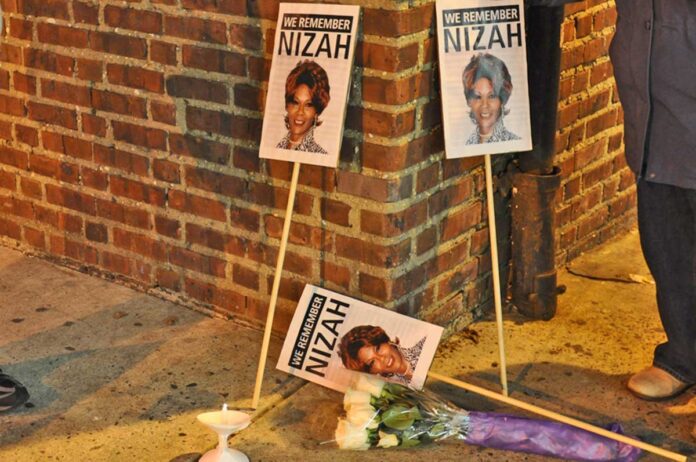Over the years, people have asked me what’s the most alarming aspect of Nizah Morris’ homicide. Was it that police gave a severely-intoxicated Trans woman of color a “courtesy ride” at 3 a.m. that ended three miles away from her intended destination? (How could that be considered courteous?)
Was it that Nizah was spotted lying unconscious on Walnut Street with a fractured skull shortly after she was no longer inside a police vehicle? Or was it that responding officers handed in paperwork to supervisors indicating a courtesy ride for Nizah never took place at all?
All of those things would strike a reasonable person as unusual, even alarming. However, at this point I would say the most alarming aspect of Nizah’s case is this: Local authorities never have asked to hear 911 tapes regarding Nizah’s death in the possession of PGN.
Both the police and the District Attorney’s Office have repeatedly stated they have no 911 transmissions relating to Nizah’s death in their homicide files. PGN has more than 80 such transmissions received from a confidential source shortly after Nizah died.
After he took office as Philadelphia’s district attorney, Larry Krasner met with Nizah’s relatives and assured them his then-homicide chief, Anthony Voci, would review the case. That was the last the family ever heard from Krasner about Voci’s putative review.
How could Voci review Nizah’s homicide and never ask for a copy of PGN’s 911 transmissions? They’re crucial to understanding the case. And if truth be told, they don’t reflect very well on the police.
For example, the tapes show that Nizah entered Officer Elizabeth Skala’s patrol car at 3:13 a.m. Dec. 22, 2002. Twelve minutes later, a passerby called 911 stating that Morris was lying unconscious along the corner of 16th and Walnut streets. (She died two days later, due to blunt-force head trauma.)
That’s a mere 12 minutes between the time a Trans woman of color enters a police vehicle and the time she’s found by a passing motorist with a fractured skull. Alarming, wouldn’t one say?
It’s worth noting 16th and Walnut (part of the 9th police district) wasn’t a high-crime area in 2002. To the contrary, Nizah’s homicide was the only homicide to occur in the 9th district that year. Who would have killed Nizah in the brief span of time when she was out of Skala’s vehicle and when a 911 caller reported seeing Nizah lying unconscious at 16th and Walnut?
Also alarming is the fact that Skala told investigators her best estimate was that she spent 16 minutes with Nizah. According to PGN’s 911 tapes, that would put Skala squarely in Nizah’s presence when she was struck. Given that scenario, it’s all-the-more shocking that authorities never have asked to review PGN’s tapes.
In actuality, three police officers responded to Nizah on the morning of her fatal head injury: Skala, Thomas Berry and Kenneth Novak. All three officers turned in paperwork to their supervisors indicating Nizah was first spotted by police in the 9th district. Thus, Nizah was assigned 9th district control numbers — control numbers that remain attached to her case to this day.
But PGN’s tapes clearly show Nizah was first spotted by Skala in the 6th district outside the old Key West Bar near 13th and Walnut streets. That’s where the ride began. Thus, Nizah’s case should have been assigned 6th district control numbers. Having Nizah’s case assigned 9th district control numbers (the district where Nizah subsequently was transported by medics to a hospital) cleared the way for officers to avoid documenting the earlier courtesy ride for Nizah.
Also, PGN’s tapes show that Skala realized Nizah was the subject of a 911 call outside Key West Bar. (The call that was placed on Nizah’s behalf due to her severe intoxication.) On the tapes, Skala conveyed to a dispatcher her recognition of Nizah being the subject of a 911 call. So if Skala subsequently told investigators she didn’t think Nizah was a target of a 911 call in the 6th district — thus there was no need to document the ride — the tapes show that to be a lie.
In short, there are many reasons why PGN’s 911 tapes are critical in answering the question: Who killed Nizah Morris? For local authorities to exhibit a lack of interest in hearing them is appalling.
Jane Roh, a spokesperson for Krasner, was asked about concerns of an inadequate investigation into Nizah’s death. Roe issued this statement: “[Y]our information is not accurate. Beyond that, I cannot say much because we do not discuss criminal investigations publicly until such time as an arrest is made by law enforcement. To date, no arrest has been made by PPD [police] in this case. If or when an arrest is made by police for this tragic homicide, we will be prepared to prosecute the defendant vigorously, as we do in all homicide cases in Philadelphia.”
In a follow-up email, Roh was asked to specify the information conveyed by PGN that’s inaccurate. As of press time, she didn’t reply.
No community should have to endure a suspicious murder of one of its own — and have authorities ignore 911 recordings that are vital to the case. What kind of investigation is that? In January, Pennsylvania will have a new governor, a new attorney general and a new state legislator for the district where Nizah was killed. One can only hope they’ll take a fresh look at Nizah’s homicide — and ask for a copy of PGN’s 911 recordings. As the saying goes, “Hope springs eternal.”
